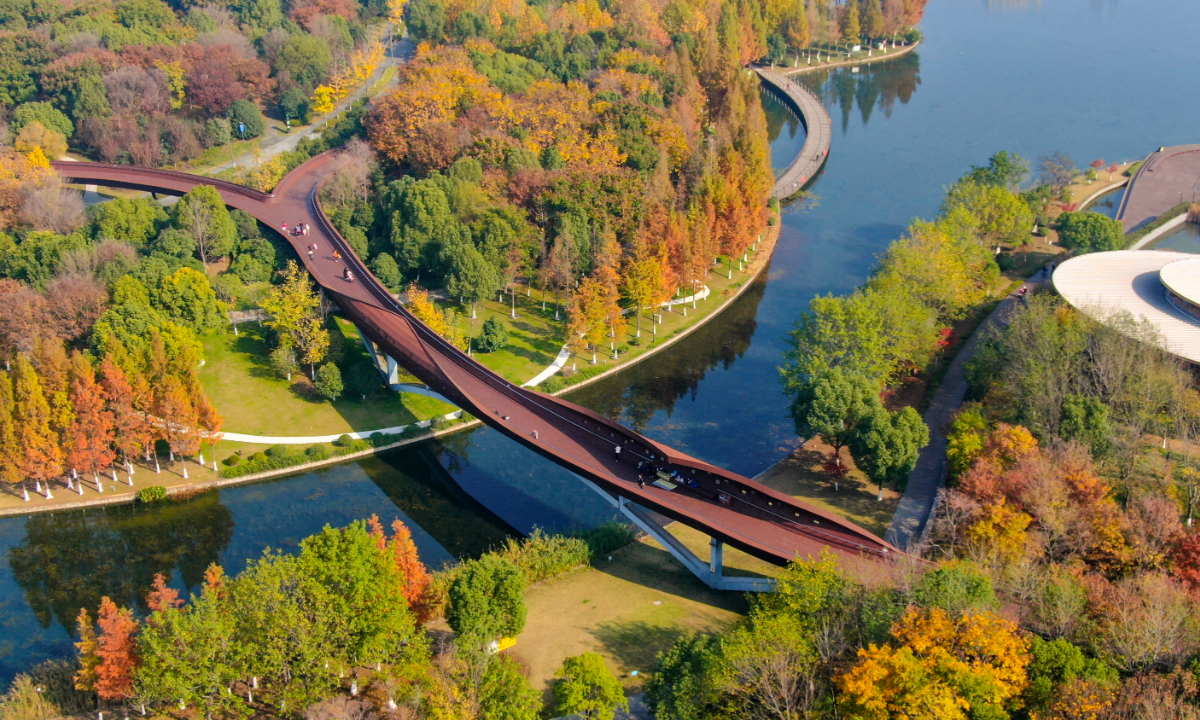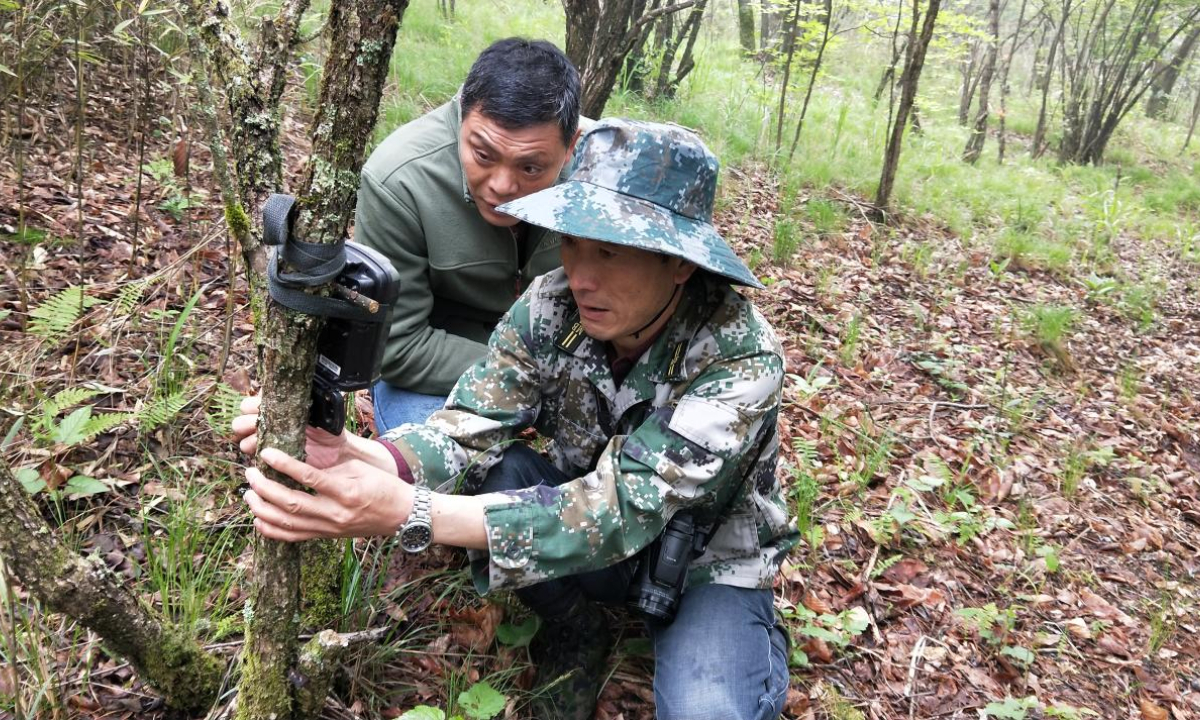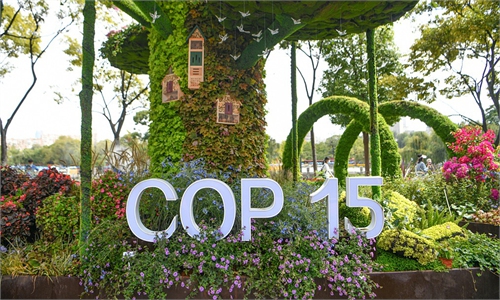IN-DEPTH / IN-DEPTH
High tech, innovative methods utilized in China to study, co-thrive with wild species
Our next-door neighbors

A view of Nanjing Hexi Urban Eco Park in East China's Jiangsu Province. Photo: VCG
Editor's Note:
Biodiversity matters to humanity's survival on the planet, and is the material basis for sustainable economic and social development. The second phase of the 15th meeting of the Conference of the Parties to the UN Convention on Biological Diversity (COP15) conclude on Monday after nearly two weeks of negotiation in Montreal, Canada. A UN deal aimed at reversing biodiversity loss and setting the world on a path of recovery has been adopted.
China, as the country currently holding the COP15 presidency, has made great strides in biodiversity protection. In recent years, wildlife protectors in China have also increasingly used innovative technologies and practices to better conserve biodiversity, which, in this issue, we will illustrate with some typical cases in the wild, as well as in some mega cities across the country.
Observing wildlife from afar

Staff members of the Hubei Wufeng Houhe National Nature Reserve install an infrared camera for monitoring wild species. Photo: Courtesy of Ministry of Ecology and Environment
Over the years, China has actively utilized advanced technology in boosting biodiversity protection that contributes to promoting the harmonious co-existence of man and Nature. The Global Times learned from the Ministry of Ecology and Environment (MEE) that the building of observation network and installation of infrared cameras are among a variety of measures used.
According to the MEE, in East China's Jiangsu Province, home to a wide variety of animals and plants, a series of effective policies and actions have been taken to effectively strengthen the level of biodiversity, especially in building a biodiversity observation network.
Since 2017, local ecology and environmental authorities have rolled out biodiversity surveys in the province. So far more than 80 percent of counties, cities, and districts in Jiangsu Province have completed said biodiversity surveys and such work continues to this day.
Based on the analysis of biodiversity conservation hotspots, Jiangsu Province has proposed to build 20 provincial-level observation stations, covering important ecosystems such as wetlands along rivers, lakes, coastal wetlands, and forests. These observation stations can conduct periodical observations, and survey and data analysis, which provide useful references for conservation work worldwide, according to local authorities.
Thousands of miles from Jiangsu Province, Longwan National Nature Reserve located in Huinan county, Northeast China's Jilin Province, is dedicated to the protection of the forest wetlands formed on the basis of volcanic landforms and the various biological species and their ecological environment.
The park established in 2003 covers a total area of 15,061 hectares and is categorized as a natural ecosystem.
The Global Times learned from the environmental authorities that the Longwan National Nature Reserve makes full use of the telecom signal towers in the area and other commanding heights in the reserve to install spherical cameras, combined with the monitoring probes to transmit the signals synchronously to the monitoring and command center platform.
Through the remote video monitoring system, integrated drones, infrared automatic trigger cameras, and the use of GPS and other equipment by management and maintenance personnel to conduct traditional ground patrols, the intelligent and information-based three-dimensional patrol of the "sky and ground" for biodiversity protection has been established.
Through these measures, more typical representative species in this area have been monitored, such as the Martes zibellina and Mergus squamatusa under the first level of national wildlife protection.
In Central China's Hubei Province, the Hubei Wufeng Houhe National Nature Reserve occupies a total area of 10,340 hectares. It belongs to the northeast branch of Wuling Mountains and is on the natural boundary between Hunan and Hubei provinces.
The Houhe reserve is the first in the province to use new technology to standardize boundary survey and establish a standard to clarify the scope of protection. By launching detailed background investigations, staff in the reserve has obtained 2000GB of investigative data and compiled 12 scientific research monographs. It was also the first in the country to use PDA to collect data, the first to independently develop a scientific research APP, and the first to implement the full grid survey method. It also spent five years in building the "1+N" information monitoring and management platform in the country, forming an "integrated sky-ground" management and protection monitoring system, and transforming the management of protected areas from the traditional extensive type to the technical quality type.
The new survey in the Houhe reserve showed that compared with 1999, the species of vascular plants in the reserve had increased from 2,292 to 3,302, the species of national key protected plants had increased from 25 to 76; the species of wild terrestrial vertebrates had increased from 369 to 417, and the number of national key protected animals has since increased from 58 to 66, according to the reserve's statistics.
In Northwest China's Gansu Province, the Annanba Wild Camel National Nature Reserve covering a total area of 396,000 hectares mainly protects wild camels (Camelus ferus) and their habitats, as well as regional deserts, wetlands, and their associated wild animals. It's known as the "delivery room" of wild camels in China.
Currently, four stations in the protected area have achieved the full coverage of network signals, and video surveillance systems have been installed at all protected stations. By setting up 74 infrared cameras, seven monitoring lines, and two sets of automatic tracking and monitoring systems, the normal monitoring of wild camels and other wild animals has been realized, laying the foundation for the development of wildlife protection.
These monitoring technologies also play a crucial role in strengthening surveillance. Since the establishment of the monitoring system, unlawful mining, the poaching of wild animals, and traversing protected areas have been effectively curbed.
Wild species as urbanites

Beijing swifts in the Beijing's Central Green Forest Park on June 27, 2022. Photo: IC
Metropolises in China are also on the vanguard of preserving biodiversity. Different from nature reserves in the wild, cities including Beijing and Shanghai continue to experiment with their own protection methods.
In the capital, social media platforms are greatly utilized to raise public awareness in boosting biodiversity. On the Twitter-like micro blogging site Sina Weibo, Beijing's environmental authorities opened an account named "Beijing Shengwu Tujian" (Beijing Biological Map Guide) aimed at using photos, videos, and other media formats to introduce protected animal species to netizens. Some 54 issues have been published on the Weibo account, garnering more than 10 million views.
Beijing's environment planners sometimes also have to deal with the protection of wild animals and protection of historical buildings. The protection of the Beijing swifts (Apus apus pekinensis) species which likes to dwell in the ancient Zhengyangmen tower, serves as an example.
Since 2018, the ecological investigation and scientific protection of the Beijing swifts population on Zhengyangmen has taken place, and the 24-hour real-time observation of nests has also followed through high-definition monitoring equipment.
At the same time, a series of research projects on the impact of the breeding of Beijing swifts on Zhengyangmen have been conducted. For the first time, it has been scientifically demonstrated that Beijing swifts have no destructive impact on the wooden structures and oil decorations of the ancient building.
In Shanghai's Changning district, special habitat gardens were built on five principles - the use of native plants, elimination of invasive plant species, enrichment of plant communities, reduction of the use of pesticides and fertilizers, and provision of supplementary food, water, or shelter for urban wildlife.
Located in the west of downtown Shanghai, Changning district is now home to eight habitat gardens, with a total renovation area of about 3,559 square meters. Among them, Leyi garden was used as a demonstration case at the COP15 to the UN Convention on Biological Diversity. During the 14th Five-Year Plan period, Changning district is expected to build at least 30 such habitat gardens, improving the quality and function of urban ecological spaces.
The Global Times learned from the MEE that before renovations, such gardens were mostly dilapidated communities and dumping grounds where the environment was terrible and biological species were relatively poor. After renovation, more than 400 types of shrubbery and flowers were added to the gardens, all of which are 100 percent native species. Now 26 species of birds, 36 species of insects, more than 20 species of pollinators, two species of frogs and four species of small mammals can be found in the gardens. The level of diversity in the gardens is close to the surrounding large patch green space.
Experts noted that the habitat gardens not only provide shelter and food for wild animals in the city, but also offer local residents leisure spaces, which could be promoted in other areas across the country.
In Shenzhen, South China's Guangdong Province, local authorities were among the first to issue a white paper and action plan on urban biodiversity, setting up a complete gross ecosystem product (GEP) accounting system, and implemented an assessment system for ecological progress.
Now about 24 percent of the land area is included in the ecological protection red line, and 1,238 parks have been built.
According to the MEE, Shenzhen has also tried to build a "city of volunteers" currently made up of 141 environment organizations and 180,000 volunteers.




